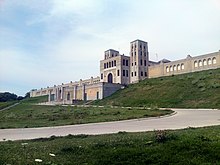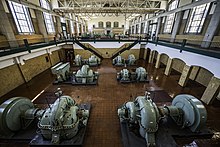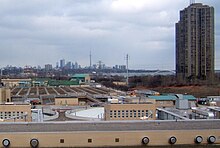
The Massachusetts Water Resources Authority (MWRA) is a public authority in the Commonwealth of Massachusetts that provides wholesale drinking water and sewage services to 3.1 million people in sixty-one municipalities and more than 5,500 large industrial users in the eastern and central parts of the state, primarily in the Boston area.
Melbourne Water is an Australian statutory authority owned by the Victorian State Government, which controls and manages much of the water bodies and supplies in metropolitan Melbourne, the capital of Victoria. Its jurisdiction includes all the reservoirs, lakes, wetlands, canals and urban creeks, and the sewerage and drainage systems that services the city.

The District of Columbia Water and Sewer Authority(DC Water) provides drinking water, sewage collection, and sewage treatment for Washington, D.C. The utility also provides wholesale wastewater treatment services to several adjoining municipalities in Maryland and Virginia, and maintains more than 9,000 public fire hydrants in Washington, D.C.

The Washington Suburban Sanitary Commission is a bi-county political subdivision of the State of Maryland that provides safe drinking water and wastewater treatment for Montgomery and Prince George's Counties in Maryland except for a few cities in both counties that continue to operate their own water facilities.
The Millard H. Robbins, Jr. Water Reclamation Plant, which is operated by the Upper Occoquan Service Authority (UOSA), is located in Centreville, Virginia and it was formerly known as the Upper Occoquan Sewage Authority. UOSA serves the western portions of Fairfax and Prince William Counties, and the Cities of Manassas and Manassas Park. The sewage treatment plant includes primary-secondary treatment and the following advanced wastewater treatment processes: chemical clarification, two-stage recarbonation with intermediate settling, multimedia filtration, granular activated carbon adsorption, chlorination for disinfection and dechlorination. The plant’s rated capacity is 54 million US gallons (200,000 m3) per day (mgd).

The Metropolitan Water Reclamation District of Greater Chicago (MWRD), originally known as the Sanitary District of Chicago, is a special-purpose district chartered to operate in Cook County, Illinois since 1889. Although its name may imply otherwise, it is not a part of the City of Chicago's local government but is created by Illinois state government with an elected Board of Commissioners. The MWRD's main purposes are the reclamation and treatment of wastewater and flood water abatement in Cook County to protect the health and safety of citizens and of area waterways. In 1900, the District notably reversed the flow of the Chicago River, and it is currently involved in the large multi-decade construction of the "Deep Tunnel," Tunnel and Reservoir Plan (TARP).
Dallas Water Utilities (DWU) is the water and wastewater service operated by the City of Dallas, Texas, in the United States. DWU is a non-profit City of Dallas department that provides services to the city and 31 nearby communities, employs approximately 1450 people, and consists of 26 programs. DWU's budget is completely funded through the rates charged for water and wastewater services provided to customers. Rates are based on the cost of providing the services. The department does not receive any tax revenues. Primary authority and rules for the department are listed in Chapter 49Archived 2006-10-04 at the Wayback Machine of the Dallas City Code.

The New York City Department of Environmental Protection (DEP) is the department of the government of New York City that manages the city's water supply and works to reduce air, noise, and hazardous materials pollution.
Water supply and sanitation in the United States involves a number of issues including water scarcity, pollution, a backlog of investment, concerns about the affordability of water for the poorest, and a rapidly retiring workforce. Increased variability and intensity of rainfall as a result of climate change is expected to produce both more severe droughts and flooding, with potentially serious consequences for water supply and for pollution from combined sewer overflows. Droughts are likely to particularly affect the 66 percent of Americans whose communities depend on surface water. As for drinking water quality, there are concerns about disinfection by-products, lead, perchlorates, PFAS and pharmaceutical substances, but generally drinking water quality in the U.S. is good.

London's water supply infrastructure has developed over the centuries in line with the expansion of London.

The Ashbridges Bay Wastewater Treatment Plant is the city of Toronto's main sewage treatment facility, and the second largest such plant in Canada after Montreal's Jean-R. Marcotte facility. One of four plants that service the city of Toronto, it treats the wastewater produced by some 1.4 million of the city's residents and has a rated capacity of 818,000 cubic metres per day. Until 1999 it was officially known as the Main Treatment Plant. The plant has a 185 m (607 ft) high smokestack which is visible from most parts of the city.
Water supply and sanitation in Israel are intricately linked to the historical development of Israel. Because rain falls only in the winter, and largely in the northern part of the country, irrigation and water engineering are considered vital to the country's economic survival and growth. Large scale projects to desalinate seawater, direct water from rivers and reservoirs in the north, make optimal use of groundwater, and reclaim flood overflow and sewage have been undertaken. Among them is the National Water Carrier, carrying water from the country's biggest freshwater lake, the Sea of Galilee, to the northern part of the Negev desert through channels, pipes and tunnels. Israel's water demand today outstrips available conventional water resources. Thus, in an average year, Israel relies for about half of its water supply on unconventional water resources, including reclaimed water and desalination. A particularly long drought in 1998–2002 had prompted the government to promote large-scale seawater desalination. In 2022, 85% of the country's drinkable water was produced through desalination of saltwater and brackish water.

Beckton Sewage Treatment Works, formerly known as Barking Sewage Works, is a large sewage treatment plant in Beckton in the east London Borough of Newham, operated by Thames Water.
Chennai Metropolitan Water Supply and Sewerage Board, known shortly as CMWSSB, is a statutory board of Government of Tamil Nadu which provides water supply and sewage treatment to the city of Chennai and its metropolitan region.

The Philadelphia Water Department is the public water utility for the City of Philadelphia. PWD provides integrated potable water, wastewater, and stormwater services for Philadelphia and some communities in Bucks, Delaware and Montgomery counties. PWD is a municipal agency of the City of Philadelphia, and is seated in rented space at the Jefferson Tower in the Market East area of Center City, Philadelphia.
Water supply and sanitation in Istanbul is the responsibility of the public utility ISKI created in 1981.
The coastal city of Chennai has a metropolitan population of 10.6 million as per 2019 census. As the city lacks a perennial water source, catering the water requirements of the population has remained an arduous task. On 18 June 2019, the city's reservoirs ran dry, leaving the city in severe crisis.
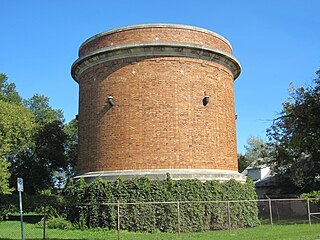
The Greater Winnipeg Water District Aqueduct (GWWDA) is an aqueduct that supplies the city of Winnipeg, Manitoba, with water from Shoal Lake, Kenora District, Ontario. Winnipeg has relied on the lake as its source for safe drinking water since the aqueduct was put in service in 1919 at a cost of nearly CDN $16 million.

The Great Lakes Water Authority (GLWA) is a regional water authority in the U.S. state of Michigan. It provides drinking water treatment, drinking water distribution, wastewater collection, and wastewater treatment services for the Southeast Michigan communities, including Wayne, Oakland, and Macomb counties, among others. GLWA overlays a majority of the water and sewer assets which were formerly operated and maintained by the Detroit Water Sewer District (DWSD) prior to the bankruptcy of the City of Detroit, Michigan.
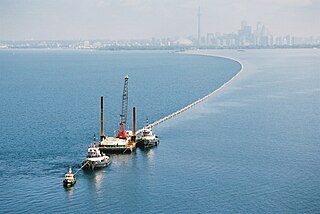
The Deep Lake Water Cooling System or DLWC is a deep water source cooling project in Toronto, Canada. As a renewable energy project, it involves running cold water from Lake Ontario, to air-condition buildings located downtown Toronto.
